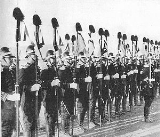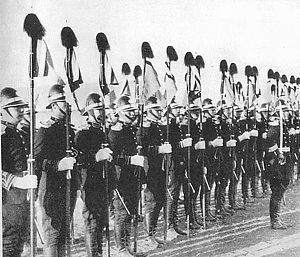
Manchukuo Imperial Guards
Encyclopedia
The Manchukuo Imperial Guards (禁衛隊) was the elite unit of the Manchukuo
armed forces created in 1933. It was charged with the protection of the Kangde Emperor
Puyi
, and senior members of the Manchukuo civil government. Its headquarters was in the capital of Hsinking, near the Imperial Palace in the center of the city.

, and was responsible primarily for the protection of the imperial household. Its members were selected from candidates of Manchu
ethnic backgrounds, and were trained independently of the Manchukuo Imperial Army
or the Japanese Kwantung Army. Although largely a ceremonial force, they received the latest firearms, and also carried Japanese-style swords (katana
) or sabers as dress weaponry. Their uniform was grey or black with silver or gold insignia
, with a five-color, five pointed star on their helmets and kepi
s.
Initially, the Guard consisted of 200 men. Later, an independent brigade called the Chinganyuchitui or “Special Guard Corps” was formed for use in special operations
during the Pacification of Manchukuo
. It was effective in combat, and participated in the Ki Feng-lung District Subjugation in November 1932 and in anti-bandit operations.
Manchukuo
Manchukuo or Manshū-koku was a puppet state in Manchuria and eastern Inner Mongolia, governed under a form of constitutional monarchy. The region was the historical homeland of the Manchus, who founded the Qing Empire in China...
armed forces created in 1933. It was charged with the protection of the Kangde Emperor
Emperor
An emperor is a monarch, usually the sovereign ruler of an empire or another type of imperial realm. Empress, the female equivalent, may indicate an emperor's wife or a woman who rules in her own right...
Puyi
Puyi
Puyi , of the Manchu Aisin Gioro clan, was the last Emperor of China, and the twelfth and final ruler of the Qing Dynasty. He ruled as the Xuantong Emperor from 1908 until his abdication on 12 February 1912. From 1 to 12 July 1917 he was briefly restored to the throne as a nominal emperor by the...
, and senior members of the Manchukuo civil government. Its headquarters was in the capital of Hsinking, near the Imperial Palace in the center of the city.

History
The Manchukuo Imperial Guard was patterned after the Imperial Guard of JapanImperial Guard of Japan
The Japanese is an organization which is dedicated to protection of the Emperor of Japan and his family, palaces and other imperial properties. Following the end of World War II the traditional Guard, which also served as a unit in the Imperial Japanese Army, was dissolved and in 1947 a civil...
, and was responsible primarily for the protection of the imperial household. Its members were selected from candidates of Manchu
Manchu
The Manchu people or Man are an ethnic minority of China who originated in Manchuria . During their rise in the 17th century, with the help of the Ming dynasty rebels , they came to power in China and founded the Qing Dynasty, which ruled China until the Xinhai Revolution of 1911, which...
ethnic backgrounds, and were trained independently of the Manchukuo Imperial Army
Manchukuo Imperial Army
The Manchukuo Imperial Army was the armed force of the Japanese dominated puppet state of Manchukuo, serving as the land forces, along with the Manchukuo Imperial Guards...
or the Japanese Kwantung Army. Although largely a ceremonial force, they received the latest firearms, and also carried Japanese-style swords (katana
Katana
A Japanese sword, or , is one of the traditional bladed weapons of Japan. There are several types of Japanese swords, according to size, field of application and method of manufacture.-Description:...
) or sabers as dress weaponry. Their uniform was grey or black with silver or gold insignia
Insignia
Insignia or insigne pl -nia or -nias : a symbol or token of personal power, status or office, or of an official body of government or jurisdiction...
, with a five-color, five pointed star on their helmets and kepi
Kepi
The kepi is a cap with a flat circular top and a visor or peak . Etymologically, the word is a borrowing of the French képi, itself a respelling of the Alemannic Käppi: a diminutive form of Kappe, meaning "cap"....
s.
Initially, the Guard consisted of 200 men. Later, an independent brigade called the Chinganyuchitui or “Special Guard Corps” was formed for use in special operations
Special operations
Special operations are military operations that are considered "special" .Special operations are typically performed independently or in conjunction with conventional military operations. The primary goal is to achieve a political or military objective where a conventional force requirement does...
during the Pacification of Manchukuo
Pacification of Manchukuo
The Pacification of Manchukuo, was a campaign to pacify the resistance to the newly established puppet state of Manchukuo between the Anti-Japanese Volunteer Armies of Manchuria and later the Communist Northeast Anti-Japanese United Army and the Imperial Japanese Army and the forces of the...
. It was effective in combat, and participated in the Ki Feng-lung District Subjugation in November 1932 and in anti-bandit operations.

